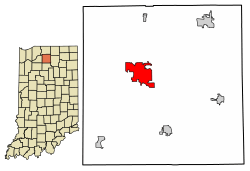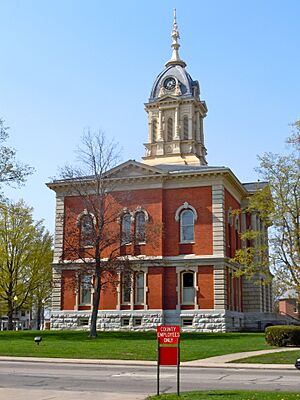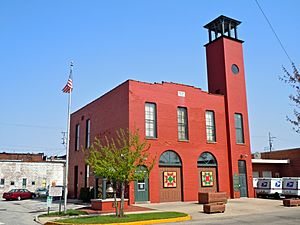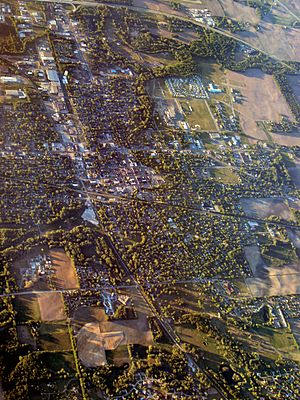Plymouth, Indiana facts for kids
Quick facts for kids
Plymouth, Indiana
|
|
|---|---|

Downtown Plymouth
|
|

Location of Plymouth in Marshall County, Indiana.
|
|
| Country | United States |
| State | Indiana |
| County | Marshall |
| Area | |
| • Total | 7.62 sq mi (19.74 km2) |
| • Land | 7.57 sq mi (19.61 km2) |
| • Water | 0.05 sq mi (0.13 km2) 0.53% |
| Elevation | 797 ft (243 m) |
| Population
(2020)
|
|
| • Total | 10,214 |
| • Density | 1,349.10/sq mi (520.88/km2) |
| Time zone | UTC-5 (EST) |
| • Summer (DST) | UTC-4 (EDT) |
| ZIP code |
46563
|
| Area code(s) | 574 |
| FIPS code | 18-60822 |
| GNIS feature ID | 0441379 |
Plymouth is a city located in Marshall County, Indiana, United States. It is the county seat, which means it's the main town where the county government is located. In 2020, about 10,214 people lived there. Plymouth is famous for being the place where the first Montgomery Ward store opened in 1926.
Contents
History of Plymouth

Early Days and First Settlers
Long ago, the land where Plymouth now stands was home to the Potawatomi Native American people. In the 1800s, the United States government made agreements to buy land from Native American tribes.
Marshall County was created in 1836. It was named after John Marshall, a very important judge in the U.S. at that time. The first settlers, many from New England, arrived in 1835. They came after the Black Hawk War ended and the Erie Canal was finished. These settlers often named new places after their hometowns. That's why Plymouth, Indiana, is named after Plymouth, Massachusetts, where the Mayflower ship landed in 1620.
Plymouth was built near the Yellow River. In 1836, a dam and a sawmill were built on the river. Many early settlers were farmers from Germany. They had to clear thick forests and drain marshy lands to grow crops like corn, wheat, and oats.
The U.S. government bought this land from the Potawatomi in 1832. This happened before the Indian Removal Act of 1830, which allowed for Native American tribes to be moved from their lands.
Plymouth became the main town of Marshall County in 1836. It got its first post office in 1837. The town officially became a city in 1851. By 1900, its population grew to 3,656 people.
The Potawatomi Trail of Death
Many Potawatomi people were forced to move to a new area in what is now Kansas. However, Chief Menominee and his group from the Yellow River did not want to leave. In September 1838, soldiers gathered them. This group of 859 Potawatomi people was forced to walk over 660 miles to Osawatomie, Kansas. This difficult journey became known as the Potawatomi Trail of Death. Sadly, more than 40 tribal members died during the march.
Later History and Important Events
On July 6, 1915, the famous Liberty Bell stopped in Plymouth. It was on its way from Philadelphia to an exhibition in San Francisco.
Plymouth's history was recorded in local newspapers. The Marshall County Republican and the Marshall County Democrat were two major papers. Over time, these papers merged and changed names. Today, the main newspaper is the Plymouth Pilot-News.
In 1966, Plymouth celebrated its 150th birthday. To mark this, the first Marshall County Blueberry Festival was held. This festival happens every year over Labor Day weekend. It brings in thousands of visitors and is one of Indiana's largest festivals.
Several buildings in Plymouth are listed on the National Register of Historic Places. These include the East Laporte Street Footbridge, the Marshall County Courthouse, and the Plymouth Fire Station.
Geography and Climate
Plymouth, Indiana, is located at 41°20′38″N 86°18′45″W / 41.34389°N 86.31250°W. It sits along the Yellow River.
The city covers about 7.57 square miles of land. Only a very small part, about 0.04 square miles, is water.
Weather in Plymouth
| Climate data for Plymouth, Indiana (1991–2020 normals, extremes 1894–present) | |||||||||||||
|---|---|---|---|---|---|---|---|---|---|---|---|---|---|
| Month | Jan | Feb | Mar | Apr | May | Jun | Jul | Aug | Sep | Oct | Nov | Dec | Year |
| Record high °F (°C) | 69 (21) |
74 (23) |
87 (31) |
90 (32) |
97 (36) |
105 (41) |
109 (43) |
103 (39) |
102 (39) |
93 (34) |
82 (28) |
71 (22) |
109 (43) |
| Mean maximum °F (°C) | 53.7 (12.1) |
56.8 (13.8) |
70.4 (21.3) |
80.3 (26.8) |
88.1 (31.2) |
93.0 (33.9) |
93.5 (34.2) |
91.8 (33.2) |
89.6 (32.0) |
82.1 (27.8) |
68.1 (20.1) |
56.3 (13.5) |
94.9 (34.9) |
| Mean daily maximum °F (°C) | 31.4 (−0.3) |
35.4 (1.9) |
47.1 (8.4) |
59.8 (15.4) |
71.2 (21.8) |
80.6 (27.0) |
83.8 (28.8) |
81.9 (27.7) |
76.1 (24.5) |
63.3 (17.4) |
48.4 (9.1) |
36.7 (2.6) |
59.6 (15.3) |
| Daily mean °F (°C) | 24.1 (−4.4) |
26.9 (−2.8) |
37.4 (3.0) |
48.9 (9.4) |
60.3 (15.7) |
70.0 (21.1) |
73.2 (22.9) |
71.5 (21.9) |
64.8 (18.2) |
52.8 (11.6) |
40.1 (4.5) |
29.8 (−1.2) |
50.0 (10.0) |
| Mean daily minimum °F (°C) | 16.7 (−8.5) |
18.5 (−7.5) |
27.7 (−2.4) |
38.0 (3.3) |
49.4 (9.7) |
59.3 (15.2) |
62.7 (17.1) |
61.0 (16.1) |
53.5 (11.9) |
42.4 (5.8) |
31.8 (−0.1) |
23.0 (−5.0) |
40.3 (4.6) |
| Mean minimum °F (°C) | −5.6 (−20.9) |
−0.6 (−18.1) |
10.4 (−12.0) |
23.0 (−5.0) |
33.5 (0.8) |
44.3 (6.8) |
50.2 (10.1) |
49.8 (9.9) |
39.0 (3.9) |
28.8 (−1.8) |
17.6 (−8.0) |
3.8 (−15.7) |
−9.0 (−22.8) |
| Record low °F (°C) | −22 (−30) |
−20 (−29) |
−6 (−21) |
16 (−9) |
26 (−3) |
36 (2) |
42 (6) |
42 (6) |
30 (−1) |
25 (−4) |
6 (−14) |
−17 (−27) |
−22 (−30) |
| Average precipitation inches (mm) | 2.63 (67) |
2.33 (59) |
2.45 (62) |
3.63 (92) |
4.33 (110) |
4.24 (108) |
4.39 (112) |
4.05 (103) |
3.20 (81) |
3.38 (86) |
3.03 (77) |
2.60 (66) |
40.26 (1,023) |
| Average snowfall inches (cm) | 18.6 (47) |
14.1 (36) |
6.4 (16) |
1.1 (2.8) |
0.0 (0.0) |
0.0 (0.0) |
0.0 (0.0) |
0.0 (0.0) |
0.0 (0.0) |
0.1 (0.25) |
3.3 (8.4) |
11.3 (29) |
54.9 (139) |
| Average extreme snow depth inches (cm) | 7.8 (20) |
7.5 (19) |
3.7 (9.4) |
0.5 (1.3) |
0.0 (0.0) |
0.0 (0.0) |
0.0 (0.0) |
0.0 (0.0) |
0.0 (0.0) |
0.0 (0.0) |
1.6 (4.1) |
4.4 (11) |
10.7 (27) |
| Average precipitation days (≥ 0.01 in) | 13.5 | 10.4 | 11.4 | 12.4 | 12.8 | 11.1 | 9.6 | 9.8 | 9.2 | 10.7 | 11.7 | 12.7 | 135.3 |
| Average snowy days (≥ 0.1 in) | 8.9 | 7.1 | 3.6 | 1.1 | 0.0 | 0.0 | 0.0 | 0.0 | 0.0 | 0.1 | 2.2 | 6.5 | 29.5 |
| Source: NOAA | |||||||||||||
Population and People
| Historical population | |||
|---|---|---|---|
| Census | Pop. | %± | |
| 1860 | 1,277 | — | |
| 1870 | 2,482 | 94.4% | |
| 1880 | 2,570 | 3.5% | |
| 1890 | 2,728 | 6.1% | |
| 1900 | 3,656 | 34.0% | |
| 1910 | 3,838 | 5.0% | |
| 1920 | 4,338 | 13.0% | |
| 1930 | 5,290 | 21.9% | |
| 1940 | 5,713 | 8.0% | |
| 1950 | 6,704 | 17.3% | |
| 1960 | 7,558 | 12.7% | |
| 1970 | 7,661 | 1.4% | |
| 1980 | 7,693 | 0.4% | |
| 1990 | 8,303 | 7.9% | |
| 2000 | 9,840 | 18.5% | |
| 2010 | 10,033 | 2.0% | |
| 2020 | 10,214 | 1.8% | |
| U.S. Decennial Census | |||
In 2010, Plymouth had 10,033 people living there. There were about 3,940 households. The city's population density was about 1,332 people per square mile.
Most people in Plymouth are White (87.2%). About 20% of the population is Hispanic or Latino. The average age in the city was 34.3 years old. About 27.9% of residents were under 18.
Economy and Jobs
Plymouth is a busy center for business in Marshall County. Many people work in manufacturing, retail, and service jobs. Some big manufacturing companies in Plymouth include Hoosier Racing Tire and Zentis. Several U.S. manufacturing headquarters are also located here. These include Oasis Lifestyle and Indiana Tool & Manufacturing, Co. Inc (ITAMCO).
Parks and Fun Activities
Plymouth has nine parks where people can relax and play.
Centennial Park
Centennial Park is the biggest park in Plymouth. It has a swimming pool, baseball and softball fields, basketball and tennis courts, and a skate park. There are also playgrounds, including a large wooden castle built in 1993. The park also features a dog park and a 2.7-mile Greenway Trail. This trail connects several parks, perfect for walking or biking.
Marshall County Blueberry Festival
Every year, over Labor Day weekend, Plymouth hosts the Marshall County Blueberry Festival. This festival is Indiana's third-largest event by attendance. It has even been named a "Top 100 Event" in North America!
Over 300 craft vendors and 100 food vendors come from all over the U.S. to show their goods. The festival also includes a classic car show, a running race, hot air balloon launches, a parade, and fireworks. There are also many sports events and three stages with free entertainment.
River Park Square
River Park Square is a newer park downtown, opened in 2014. It has a stage, seating, and a splash pad. This park is home to Plymouth's Saturday Farmer's Market. It also hosts the Yellow River Festival, the Latino Festival, and the Mayor's Month of Music in August.
Other Parks
Packard's Wood Park has sports facilities and an all-inclusive play center called Freedom Park. Magnetic Park has a playground, a fishing pond, and a gazebo. It also has the Conservation Clubhouse, which can be rented for events.
Places to Visit
Plymouth has a public library called the Plymouth Public Library. It is located on North Center Street. The library aims to help everyone in the community. It provides resources for education, information, and fun activities.
Famous People from Plymouth
Entertainers
- Raymond Walburn: Born in Plymouth, he became an actor. He appeared in movies from 1916 to 1955.
- Nick and Will Kubley: These brothers from Plymouth were involved with Kidz Bop. They later formed a group called Passafire, which makes reggae versions of nursery rhymes.
Athletes and Coaches
- Noble Kizer: He played football at the University of Notre Dame. Later, he became the head football coach at Purdue University from 1930 to 1936. He was added to the Indiana Football Hall of Fame in 1977.
- Steve Yoder: Born in Plymouth, he graduated from Plymouth High School in 1958. He played basketball and baseball in college. Yoder coached basketball at Plymouth High School, Ball State University, and the University of Wisconsin–Madison. He also worked as a scout for the Indiana Pacers and New York Knicks.
- Scott Skiles: He graduated from Plymouth High School in 1982. He played professional basketball for teams like the Orlando Magic and Milwaukee Bucks. Skiles also coached for the Phoenix Suns, Chicago Bulls, and Orlando Magic. On December 30, 1990, he set an NBA record with 30 assists in one game, which is still the record today.
- Morgan Uceny: Born in Plymouth, she graduated from Cornell University. She became a four-time All-American athlete. She won the National Title for the 1500m race, which qualified her for the 2012 Summer Olympics in London.
Images for kids
See also
 In Spanish: Plymouth (Indiana) para niños
In Spanish: Plymouth (Indiana) para niños







